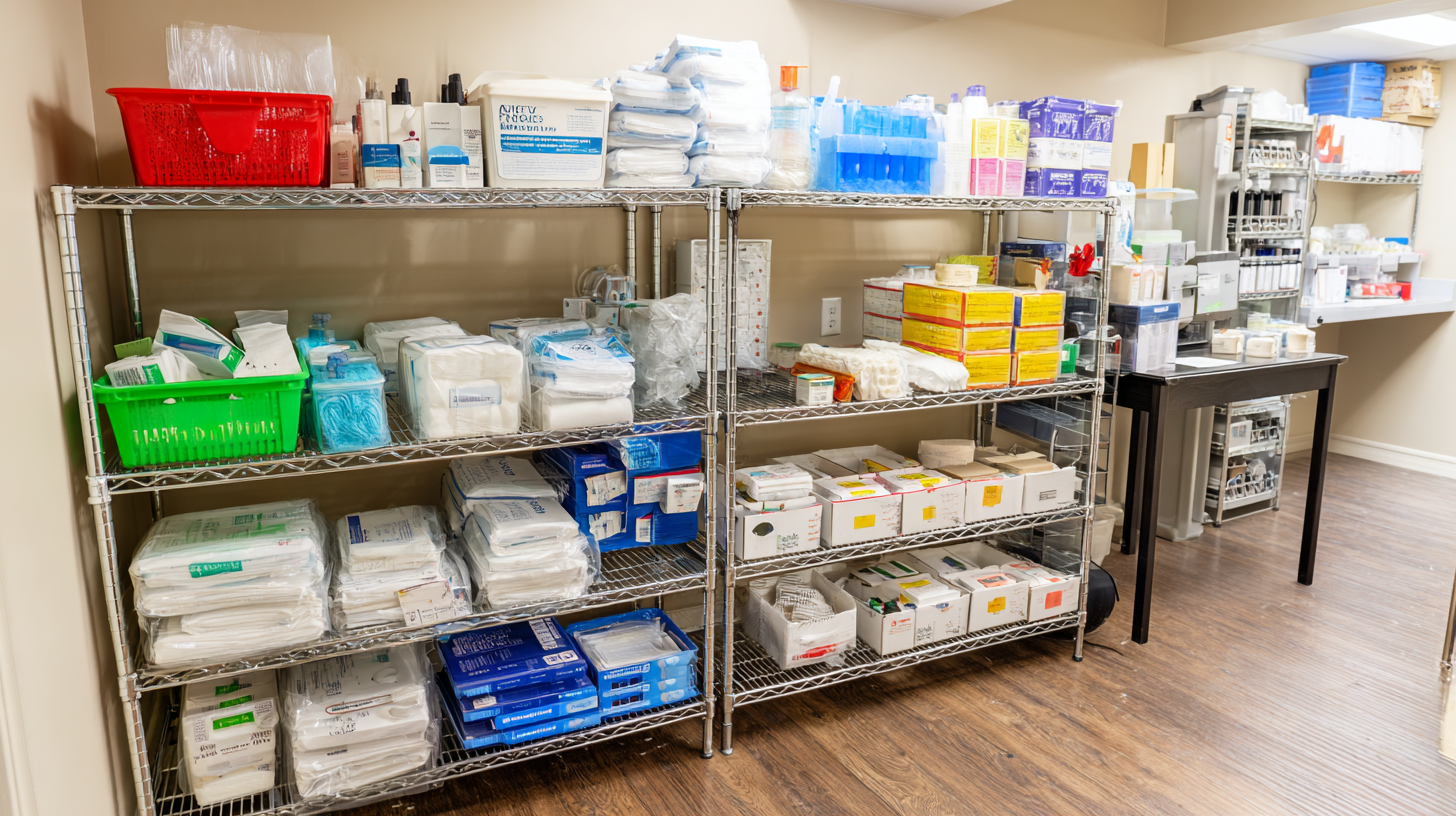Click here to browse our On The Mend Portfolio!
Navigating Challenges in Home Health Care Supplies: Common Issues and Solutions
The home health care supplies industry has witnessed significant growth, driven by an increasing aging population and rising chronic health conditions. According to a report by MarketsandMarkets, the global home healthcare market is projected to reach approximately $400 billion by 2025, with home health care supplies playing a pivotal role in this expansion.

However, providers and caregivers face numerous challenges in sourcing, managing, and utilizing these essential supplies effectively. Common issues include supply chain disruptions, accounting for a staggering 45% of inefficiencies in the healthcare sector, and difficulties in integrating technology to streamline operations. These challenges not only hinder patient care but can also lead to increased costs and decreased patient satisfaction.
Therefore, identifying the root causes of these issues and exploring viable solutions is crucial for enhancing the efficiency and effectiveness of home health care supplies management.
Challenges in Sourcing Home Health Care Supplies: Market Trends and Insights
The home health care supplies market is experiencing significant shifts due to changing consumer demands and technological advancements. As organizations attempt to source these supplies, they often encounter challenges such as supply chain disruptions, fluctuating costs, and the need for compliance with regulatory standards. The recent trend of prioritizing supply chain resilience amidst policy changes is crucial for ensuring that home health care providers can maintain consistent access to essential supplies. Companies must adapt their sourcing strategies to navigate these complexities, focusing on building strong relationships with suppliers and leveraging technology for better inventory management.
Emerging technologies are playing a vital role in transforming how home health care supplies are sourced. Organizations are increasingly exploring open innovation models to enhance collaboration across the supply chain, which enables faster response times and greater adaptability to market trends. As consumer preferences evolve towards more personalized care options, companies that embrace innovation and remain flexible will be better positioned to meet these demands. By keeping a pulse on market insights and leveraging data analytics, businesses can refine their sourcing processes and ultimately improve patient care outcomes.
Impact of Supply Chain Disruptions on Home Health Care Equipment Availability
Supply chain disruptions have emerged as a significant challenge in the home health care sector, directly impacting the availability of essential equipment and supplies. Factors such as global shipping delays, local shortages, and increased demand can lead to critical shortages of items like oxygen concentrators, wheelchairs, and protective gear. This scarcity not only hampers the delivery of quality care but can also place additional stress on both patients and healthcare providers who rely on these supplies for daily operations.
To mitigate the effects of these disruptions, healthcare providers must adopt proactive strategies, such as diversifying suppliers and leveraging technology for better inventory management. Collaborating with local manufacturers can also be beneficial, as it reduces dependency on international shipping and fosters quicker response times. Additionally, maintaining open lines of communication with stakeholders can help anticipate shortages and develop contingency plans that ensure continuity of care. By addressing these supply chain challenges head-on, the home health care industry can improve the resilience of its operations and better serve its patients.
Navigating Challenges in Home Health Care Supplies
Technological Innovations Addressing Inventory Management in Home Health Care
In the evolving landscape of home health care, effective inventory management is paramount for ensuring that patients receive the necessary supplies seamlessly. Recent advancements in technology, particularly with the adoption of specialized software solutions, are addressing the common hurdles associated with supply chain inefficiencies. For instance, the recent acquisition of an enterprise software provider aimed at durable medical equipment demonstrates a significant step toward enhancing operational efficiency in managing health care supplies. Such innovations streamline processes, allowing providers to manage their inventories accurately and respond swiftly to changing patient needs.
Moreover, the push for digital health innovation in various regions, including Africa, highlights the growing recognition of technology's role in transforming health systems. Connecting local health tech startups with funding opportunities fosters an environment for innovative digital solutions that cater to specific challenges in home health care. As health services continue to grapple with complexity, leveraging smart supply chain technologies can significantly improve not only inventory management but also overall operational performance, ultimately leading to better patient outcomes and a more responsive healthcare environment.

Strategies for Ensuring Compliance with Health Care Supply Regulations
Compliance with health care supply regulations is crucial for ensuring the safety and effectiveness of home health care products. With an estimated 3.5 million people in the U.S. receiving home health care services, the demand for compliant and high-quality supplies is at an all-time high. According to a report by the Home Health Care News, approximately 50% of home health agencies struggle with adherence to federal regulations, leading to significant operational challenges and risks, including fines and increased scrutiny from governing bodies.
To navigate these challenges, health care suppliers must implement robust strategies to ensure compliance. Regular training programs for staff on the latest regulations are essential, as evidenced by a study from the National Association for Home Care & Hospice, which found that agencies with mandatory compliance training reported a 25% decrease in regulatory violations. Additionally, leveraging technology, such as compliance management software, can streamline tracking of inventory and adherence to standards. By proactively addressing compliance issues, home health care suppliers can enhance their operational efficiency and ultimately improve patient outcomes.
Cost-Effectiveness of Sustainable Practices in Home Health Care Supplies
In the realm of home health care, the cost-effectiveness of sustainable practices is increasingly becoming a focal point for both suppliers and caregivers. By prioritizing eco-friendly materials and processes, providers can reduce operational costs while offering high-quality care. For instance, using biodegradable supplies not only decreases waste but also lessens the environmental impact, leading to savings in disposal and management costs over time. Organizations that adopt sustainable practices often find that they can lower expenses related to purchasing and waste disposal, ultimately benefiting both their budgets and the planet.
Moreover, consumers are increasingly drawn to companies that demonstrate a commitment to sustainability. A clear focus on eco-friendly practices not only strengthens brand loyalty but also opens up new market opportunities. As hospitals and healthcare facilities shift towards greener policies, home health care suppliers that align with these values position themselves as forward-thinking and responsible. By investing in sustainable supply chains, companies enhance their reputation while also appealing to an environmentally-conscious customer base, proving that profitability and sustainability can go hand in hand in the home health care sector.

Related Posts
-

Global Market Insights for Home Health Care Supplies and Effective Strategies to Succeed in 2025
-

5 Compelling Benefits of Choosing Home Health Equipment for Global Buyers
-

Exploring Innovative Options for At Home Medical Supplies
-

Driving Innovation in Dme Medical Equipment at the Record Breaking Canton Fair 2025
-

Comprehensive Guide to Best Medical Supply Equipment: Essential Specifications and User Tutorials
-

Exploring the 2025 Tech Innovations in Best Home Health Supplies and How to Leverage Them for Global Sourcing
View Products
- Bathroom Safety & Shower Systems
- Canes, Knee Walkers, Rollators & Wheelchairs
- Compression Socks, Stockings & Custom Garments
- CPAP Machines, Devices, Accessories & Supplies
- Incontinence Supplies
- Lift, Reclining, and Sleeper Chairs
- Power Scooters, Power Chairs & Accessories
- Ramps & Handicap Access
- Stair, Platform & Portable Lifts
- Blog
Our Locations
Visit Us in CT, NY & CA
Looking for a 'medical store near me'? Call On The Mend for the equipment and service you need!
